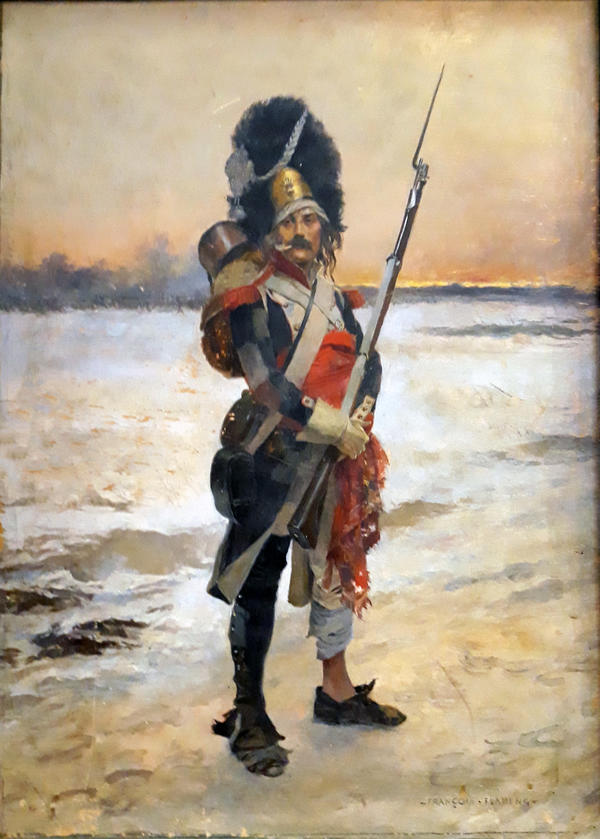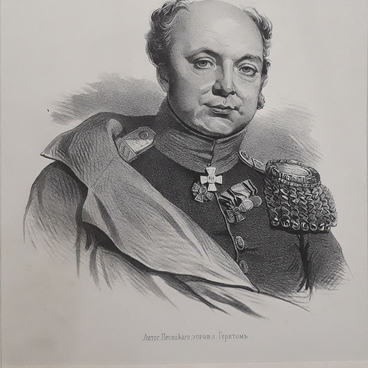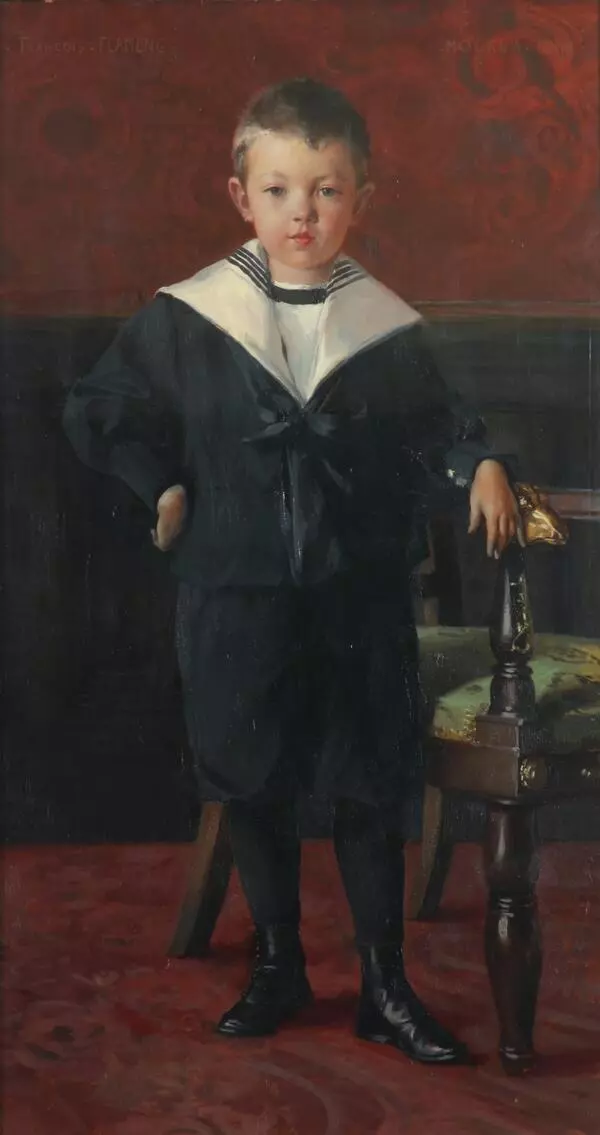The exact date when French Grenadier was painted is unknown; Francois Flameng, a French artist, painted it around the 1880s. The painting got into the Tambov Ethnography Museum in 1921.
The painting depicts a French grenadier during the Patriotic War of 1812, during the retreat of Napoleon’s army from Russia in October-December. By that time, the Russian army under the command of Field Marshal Kutuzov had recaptured the initiative in the war. Having won the Battle of Maloyaroslavets on October 24, the regular army prevented Napoleon from entering the Old Kaluga Road leading to the provinces untouched by the war. The French had to retreat along the empty Smolensk road, which they plundered themselves on their way to Moscow.
Flying guerrilla groups and militia attacked Napoleon’s troops trailing back every now and then, peasants rebelled and refused to give grain. The French would lose their weapons, suffer from diseases and wounds, go hungry and freeze to death.
The grenadier in François Flameng’s painting retained his weaponry, but his outfit got worn out. The soldier is wearing a blue uniform with white lapels and turn-up cuffs, one of the sleeves is patched-up. He is covered with a warm red shawl over his uniform. Red epaulettes are still on his shoulders, and on his side the artist painted a cartridge bag. On his head the grenadier has a bear fur hat with a copper blaze showing a hand grenade with a fuse, filled with gunpowder. The soldier is also wearing torn white culottes — short trousers that fastened under his knees and shabby black gaiters — warm upper stockings.
The soldier in Flameng’s painting looks tall. Napoleon’s grenadier companies enrolled physically strong battle-hardened soldiers, no less than 176 centimetres tall. Grenadiers would normally be listed of infantry soldiers from the fusiliers regiment. It was considered a promotion. During the offensive, grenadier units were the first to go, blowing up the enemy’s fortifications and piercing the way for the fusiliers with their bayonets and buttstocks.
François Flameng is a famous French artist who worked in the second half of the 19th — first half of the 20th century. After graduating from the School of Fine Arts, he became interested in historical painting and portraits. That made the author famous. French Grenadier belongs to that period of the artist’s work.
Flameng decorated the Sorbonne’s main staircase and the national Opera Comique with frescoes. He designed banknotes of 1,000 and 5,000 francs for the French Bank, did commercial painting and created posters and show bills.
After the First World War, the artist refocused to battle painting. The paintings of this period were notable for their realism and psychologism. The characters in his paintings were not heroes. Some critics mocked Flameng for that.
The painting depicts a French grenadier during the Patriotic War of 1812, during the retreat of Napoleon’s army from Russia in October-December. By that time, the Russian army under the command of Field Marshal Kutuzov had recaptured the initiative in the war. Having won the Battle of Maloyaroslavets on October 24, the regular army prevented Napoleon from entering the Old Kaluga Road leading to the provinces untouched by the war. The French had to retreat along the empty Smolensk road, which they plundered themselves on their way to Moscow.
Flying guerrilla groups and militia attacked Napoleon’s troops trailing back every now and then, peasants rebelled and refused to give grain. The French would lose their weapons, suffer from diseases and wounds, go hungry and freeze to death.
The grenadier in François Flameng’s painting retained his weaponry, but his outfit got worn out. The soldier is wearing a blue uniform with white lapels and turn-up cuffs, one of the sleeves is patched-up. He is covered with a warm red shawl over his uniform. Red epaulettes are still on his shoulders, and on his side the artist painted a cartridge bag. On his head the grenadier has a bear fur hat with a copper blaze showing a hand grenade with a fuse, filled with gunpowder. The soldier is also wearing torn white culottes — short trousers that fastened under his knees and shabby black gaiters — warm upper stockings.
The soldier in Flameng’s painting looks tall. Napoleon’s grenadier companies enrolled physically strong battle-hardened soldiers, no less than 176 centimetres tall. Grenadiers would normally be listed of infantry soldiers from the fusiliers regiment. It was considered a promotion. During the offensive, grenadier units were the first to go, blowing up the enemy’s fortifications and piercing the way for the fusiliers with their bayonets and buttstocks.
François Flameng is a famous French artist who worked in the second half of the 19th — first half of the 20th century. After graduating from the School of Fine Arts, he became interested in historical painting and portraits. That made the author famous. French Grenadier belongs to that period of the artist’s work.
Flameng decorated the Sorbonne’s main staircase and the national Opera Comique with frescoes. He designed banknotes of 1,000 and 5,000 francs for the French Bank, did commercial painting and created posters and show bills.
After the First World War, the artist refocused to battle painting. The paintings of this period were notable for their realism and psychologism. The characters in his paintings were not heroes. Some critics mocked Flameng for that.




